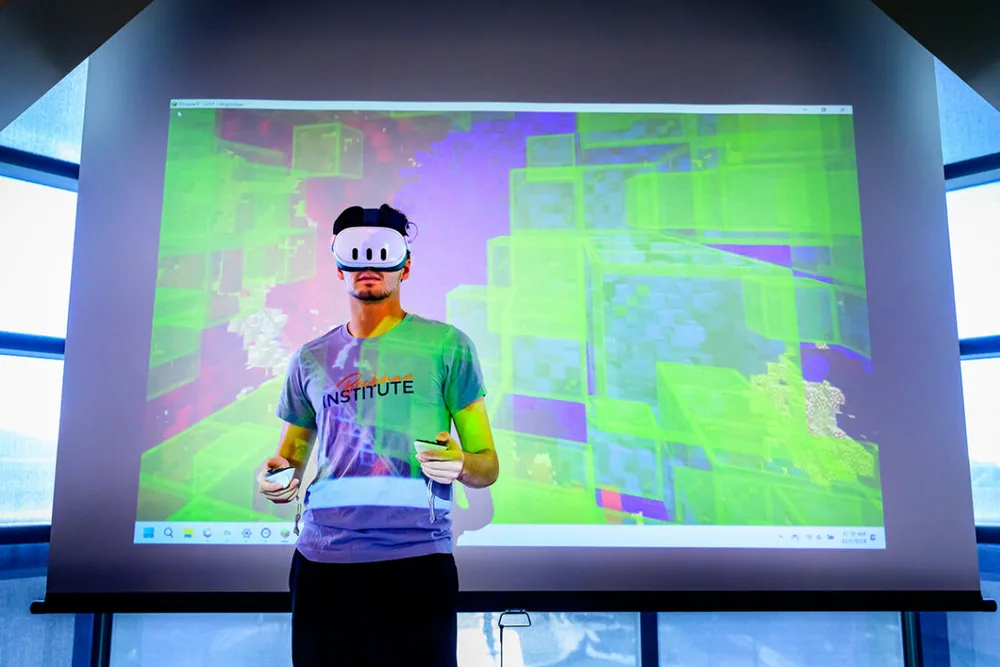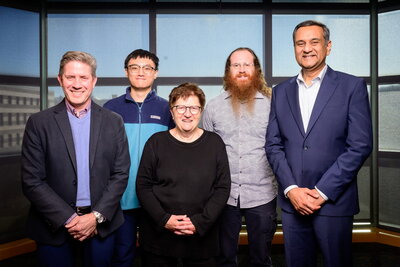
Scientists have translated nanoscale experimental and computational data into precise 3D representations of bacteria, yeast and human epithelial, breast and breast cancer cells in Minecraft, a video game that allows players to explore, build and manipulate structures in three dimensions. The innovation will allow researchers and students of all ages to navigate biological cells, puncturing through the membranes of organelles to view their interiors or wandering across the cytoplasm to see how the various structures are distributed within the cell.
CraftCells: A Window into Biological Cells is the first broadly accessible tool allowing users to get an accurate picture of whole cells in 3D, said Zaida (Zan) Luthey-Schulten, a professor of chemistry and of physics at the University of Illinois Urbana-Champaign who led the work with Illinois bioengineering professors Stephen Boppart and Rohit Bhargava, graduate student Kevin Tan, postdoctoral researchers Zane Thornburg and Seth Kenkel, and study lead author Tianyu Wu, a biophysics graduate student at the U. of I. Their work is described in the journal The Biophysicist.
“I have dedicated the last 10 years of my life to developing representations of the three dimensions of space plus time in models and 4D simulations of cells,” Luthey-Schulten said. “I think it is of fundamental importance to move away from the 2D images that you see in textbooks to get into the 3D world and see how these cells are organized.”
Visit the News Bureau website to see more photos and video with this story.

More intricate 3D visualizations of molecular data are available to some members of the scientific community. Programs like NAMD and VMD, open-source software platforms developed at the U. of I., can simulate and visualize the behavior of large biological systems involving millions of atoms. While these simulations offer extraordinary insights into molecular interactions, they require vast computing power, making them inaccessible to most people, Tan said.
“Currently, there’s no real way for the public to have this three-dimensional visualization of biological cells. And even within the scientific community, it’s not common to have such an easy-to-use 3D visualization,” he said.
The team relied on high-resolution microscopic data to build their models of cells, focusing on cells of special interest to researchers and to the public. Their first 3D models are of a yeast cell, epithelial cells from both cancerous and healthy breast tissue, and a “minimally viable” bacterial cell, which has been stripped of all genes that are not essential to life.
These cellular worlds can be viewed in 3D using a virtual reality headset. Players select from a menu of Minecraft worlds containing the cell type of interest to begin their exploration.
The bacterial cell is unlike the others in that bacteria contain no nuclei. The DNA floats freely in the cytoplasm rather than being confined inside any membrane-bound organelles.
The breast cancer cell differs from its healthy counterpart in visually apparent ways. The shape of the breast cancer cell is more elongated and pointier, and the nucleoli within the nucleus are much larger than in the healthy cells.
“When a cancer cell becomes elongated, that spindle-like morphology is often associated with metastasis — so more aggressive cancers,” Tan said. “And histopathologists often look at the size of the nucleoli as a marker of cancer.”
CraftCells is educational and fun, Luthey-Schulten said. Standard Minecraft tools and weapons have been modified to simulate real-world cellular events. Players can experience the tissue-damaging effects of reactive oxygen species, for example. In the bacterial cells, players can hitch a ride on a rollercoaster that threads its way through golden ribbons of DNA and red cytoplasmic proteins. The team plans to develop a weapon that allows players to shoot at breast cancer cells, emulating a medical procedure known as laser ablation.
Many molecules, including water, are left out of the visualizations, allowing players to see and navigate around the most prominent cellular structures. Features like proteins, DNA or cell membranes can be turned off and on again to focus on individual parts of the cell and understand how they come together.
Each 3D pixel, or voxel, is sized to give the best view of the cell, the researchers said. Depending on the cell type, individual voxels range from one to 100 nanometers in size.
Scientists may use CraftCells to better understand their study systems, the researchers said.
“We’ve learned from the program VMD that it is critical to look at your system in three dimensions to make sure everything makes sense,” Thornburg said. “And even though VMD is fantastic, nothing gives you the scale like this where you can enter and walk around the entire cell and do so many checks on your system. CraftCells is just another level of 3D exploration that no other scientific tool currently provides.”
Future iterations of cells may allow scientists to explore different cell states, Wu said.
“We may be able to show how some targeted drugs get into human cells or see the changes that occur when a yeast cell produces ethanol,” he said. “CraftCells can give us an easier way to understand these biological processes.”
CraftCells is available free of charge and is compatible with the MineCraft Java, Bedrock and Education editions. To download the program, go to: https://github.com/Luthey-Schulten-Lab/CraftCells
Luthey-Schulten, Boppart and Bhargava are professors in the Beckman Institute for Advanced Science and Technology. Bhargava is the director of the Cancer Center at Illinois.
This work was conducted at the National Science Foundation Science and Technology Center for Quantitative Cell Biology in the Beckman Institute at the U. of I. The Cancer Center at Illinois, the U.S. Department of Energy’s Small Business Innovation Research and Office of Energy Efficiency also supported this research.
In the news:
Forbes article: Explore The Inside Of A Biological Cell In Minecraft
_____________________________________________________________________
Editor's note:
To reach Zaida Luthey-Schulten, email zan@illinois.edu.
To reach Kevin Tan, email kevinkt2@illinois.edu.
To reach Zane Thornburg, email zanert2@illinois.edu.
To reach Tianyu Wu, email tianyu16@illinois.edu.
The paper “Visualizing cell structures with Minecraft” is available online.
DOI: 10.35459/tbp.2024.000275